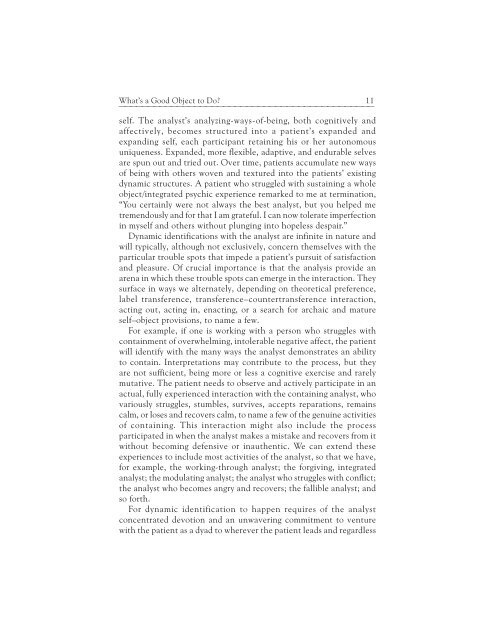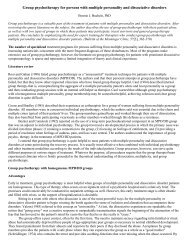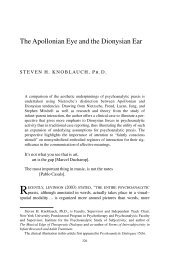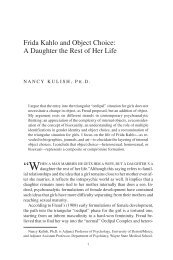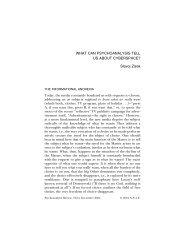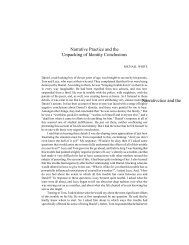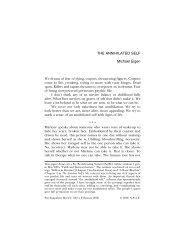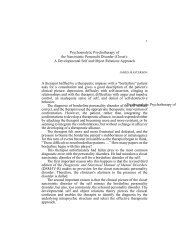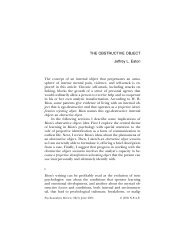What's a Good Object to Do? - PsyBC
What's a Good Object to Do? - PsyBC
What's a Good Object to Do? - PsyBC
You also want an ePaper? Increase the reach of your titles
YUMPU automatically turns print PDFs into web optimized ePapers that Google loves.
What’s a <strong>Good</strong> <strong>Object</strong> <strong>to</strong> <strong>Do</strong> 11<br />
⎯⎯⎯⎯⎯⎯⎯⎯⎯⎯⎯⎯⎯⎯⎯⎯⎯⎯⎯⎯⎯⎯⎯⎯⎯⎯⎯⎯⎯⎯⎯⎯⎯⎯⎯⎯⎯⎯⎯⎯⎯⎯⎯⎯<br />
self. The analyst’s analyzing-ways-of-being, both cognitively and<br />
affectively, becomes structured in<strong>to</strong> a patient’s expanded and<br />
expanding self, each participant retaining his or her au<strong>to</strong>nomous<br />
uniqueness. Expanded, more flexible, adaptive, and endurable selves<br />
are spun out and tried out. Over time, patients accumulate new ways<br />
of being with others woven and textured in<strong>to</strong> the patients’ existing<br />
dynamic structures. A patient who struggled with sustaining a whole<br />
object/integrated psychic experience remarked <strong>to</strong> me at termination,<br />
“You certainly were not always the best analyst, but you helped me<br />
tremendously and for that I am grateful. I can now <strong>to</strong>lerate imperfection<br />
in myself and others without plunging in<strong>to</strong> hopeless despair.”<br />
Dynamic identifications with the analyst are infinite in nature and<br />
will typically, although not exclusively, concern themselves with the<br />
particular trouble spots that impede a patient’s pursuit of satisfaction<br />
and pleasure. Of crucial importance is that the analysis provide an<br />
arena in which these trouble spots can emerge in the interaction. They<br />
surface in ways we alternately, depending on theoretical preference,<br />
label transference, transference–countertransference interaction,<br />
acting out, acting in, enacting, or a search for archaic and mature<br />
self–object provisions, <strong>to</strong> name a few.<br />
For example, if one is working with a person who struggles with<br />
containment of overwhelming, in<strong>to</strong>lerable negative affect, the patient<br />
will identify with the many ways the analyst demonstrates an ability<br />
<strong>to</strong> contain. Interpretations may contribute <strong>to</strong> the process, but they<br />
are not sufficient, being more or less a cognitive exercise and rarely<br />
mutative. The patient needs <strong>to</strong> observe and actively participate in an<br />
actual, fully experienced interaction with the containing analyst, who<br />
variously struggles, stumbles, survives, accepts reparations, remains<br />
calm, or loses and recovers calm, <strong>to</strong> name a few of the genuine activities<br />
of containing. This interaction might also include the process<br />
participated in when the analyst makes a mistake and recovers from it<br />
without becoming defensive or inauthentic. We can extend these<br />
experiences <strong>to</strong> include most activities of the analyst, so that we have,<br />
for example, the working-through analyst; the forgiving, integrated<br />
analyst; the modulating analyst; the analyst who struggles with conflict;<br />
the analyst who becomes angry and recovers; the fallible analyst; and<br />
so forth.<br />
For dynamic identification <strong>to</strong> happen requires of the analyst<br />
concentrated devotion and an unwavering commitment <strong>to</strong> venture<br />
with the patient as a dyad <strong>to</strong> wherever the patient leads and regardless


